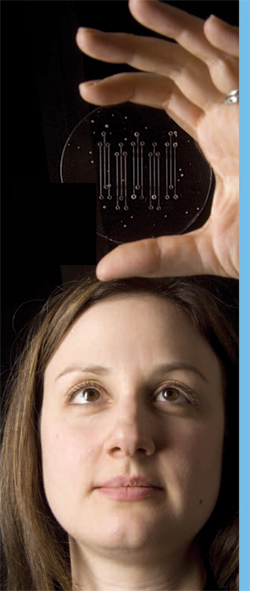Moving Research into Action
 Catherine Klapperich: Catherine Klapperich:
High-tech Disposables
For some life-threatening diseases, treatments exist but the route to diagnosis is costly, slow, and cumbersome. Often health-care workers must wait hours or even days for laboratory test results before they can diagnose and treat patients. Workers in the field or in developing countries, without access to expensive equipment or even a power supply, can face a daunting task in reaching even the most straightforward diagnosis.
Biomedical engineer Catherine Klapperich, another Coulter award winner, is developing a small, disposable diagnostic device, sometimes referred to as a “lab-on-a-chip” that may eliminate this problem and allow point-of-care testing and field-based analysis even in remote areas. She and her students are conducting the initial work to develop a range of labs-on-chips to diagnose dangerous
bacterial infections or signal the presence of biomarkers that may predict life-threatening events.
One chemical that Klapperich is targeting is C-reactive protein (CRP). This biomarker of heart disease can predict a second event for someone who’s had a previous heart attack or even a first event for seemingly healthy patients. Traditionally, physicians determine levels of CRP by taking a vial of blood, spinning it down in a centrifuge, removing the serum layer, and performing a lengthy test called an enzyme-linked immunosorbent assay (ELISA). “With a traditional ELISA you are washing the thing half the day,” Klapperich says, referring to the many steps involved in the test. “We want something that is quick, disposable, and simple to use, and that has an easy-to-read output.”
Her solution is a plastic chip a few inches long, imprinted with microfluidic channels each roughly the size of a human hair. These channels have a very high surface to volume ratio, speeding the ELISA reaction and reducing the length of the test to less than 30 minutes. A chemiluminescent substrate reacts with antibodies that bind CRP to produce an image on instant film that can be easily read by a health worker.
The chip’s disposability, speed of analysis, and small sample requirement, says Klapperich, might make it ideal for a wide range of biomarkers. She is also working on a version of the chip to detect influenza viruses and help control the spread of a flu pandemic. The classic way to diagnose influenza infection is with a hemagglutination assay, which indicates a flu virus is present but not which strain. To diagnose a specific flu, a PCR (polymerase chain reaction) must be run to amplify the DNA. By replacing the ELISA step with a PCR step, the researchers hope to detect the specific flu virus quickly so that steps can be taken to combat its spread.
Another worrisome invader is C. difficile, a bacterium that causes debilitating diarrhea, often in patients who are already sick and taking antibiotics for other illnesses. Experts also worry that antibiotic resistance may make C. difficile more virulent over time. The current test to diagnose C. difficile infection involves a 2–4 day wait to see if the patient’s fecal sample kills cultured fibroblasts, but it provides no information about the strain of bacteria infecting the patient. Klapperich’s PCR device could enable a quick and precise analysis of the infection by purifying and extracting its nucleic acids, and prevent inappropriate usage of antibiotics.

“I’m really interested in making a difference by enabling point-of-care diagnosis of emerging diseases in poor countries,” she says. “What we’re facing is primarily an engineering problem—bringing the test down to a tiny scale and making something that can be manufactured in quantity.” The main hurdle is sample preparation, either filtering blood to remove proteins or lysing tough bacterial cells to isolate the nucleic acids. Klapperich adds that if they can succeed in developing a field-based tool, without the need for external power or a refrigerator to store reagents, then they can start thinking about the device’s utility in developing countries. “You could actually change the spread of some nasty diseases with this device.”
For more information, see www.klapperichlab.org.
— by Leah Eisenstadt
|






 Catherine Klapperich:
Catherine Klapperich: 